Reviews
Katri Lipson: Kosmonautti [The cosmonaut]
30 December 2008 | Mini reviews
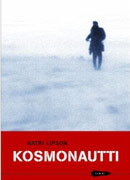 Kosmonautti
Kosmonautti
[The cosmonaut]
Helsinki: Tammi, 2008. 199 p.
ISBN 978-9513-142940
€ 22.50, hardback
Kosmonautti is a reflective first novel by a mature author; Lipson (born 1965), a medical doctor, has succeeded in weeding out the non-essential. In a cold, dark Murmansk during the final decade of the Soviet Union, three people live out their dreams. Seryozha is the good boy who adores space travel and his beautiful music teacher, Svetlana Kovalevna. She is harassed both in the classroom and in the staffroom, and by her snooping neighbours in the communal apartment. More…
Happiness is a warm gun?
30 September 2008 | Authors, Reviews

Petri Tamminen. Photo: Ville Juurikkala
‘As a group, we’re prone to getting pissed-off’ sums up one interviewee in Petri Tamminen’s new book — his seventh — Mitä onni on (‘What happiness is’, Otava, 2008). And that is exactly what this story is about — an analysis of the causes and consequences of the blues inherent to true Finnishness.
What’s wrong with the Finns? A shared national penchant for playing in a minor key, difficult weather conditions, an excess amount of the protestant work ethic, or what? Two friends — an author and an artist — initiate a field research project with the intent of publishing a book. The episodic narrative takes them on a cruise ship to Sweden, through a university and an eco-commune and all the way to Denmark to interview people with one question: What is happiness? More…
Over the rainbow
Issue 2/2008 | Archives online, Authors, Reviews
Poet, novelist and dramatist Juhani Peltonen (1941–1998) wrote about love, loneliness and melancholy in a manner uniquely distinguished by a playful gloominess, a sense for deeply gripping-comic tragedy and a virtuosic ability to mould language into any shape he pleased.
In his novel Maanäären viinitarhurit (‘The vintners of the ends of the earth’, 1976), Juhani Peltonen tells of the ‘atheistic Orthodox’, who are afflicted by an incessant wanderlust, but who never go anywhere. The atheistic Orthodox do not believe in God themselves, but they are convinced that the painters of the icons that adorn their beautiful churches must have seen God, if even just a glimpse.
This sort of coincidentia oppositorum, in which the longing for faraway places and homesickness combine as a melancholy wanderlust, symbolises the whole of Juhani Peltonen’s output.
The author of seven collections of poetry and seven novels, four plays and four collections of short stories, Peltonen debuted as a poet. He is best known for his novels and short stories, though he wrote those with his poet’s pen as well; reckless lyricism in even his declarative statements became his trademark. More…
In the woods
30 June 2008 | Authors, Reviews

The tale of Hansel and Gretel is an ancient one, woven around the themes of abandonment, cannibalism, and the terrors of dark forests in those forests’ ancient heyday. Told, edited and retold by the German Brothers Grimm in the early 19th century, the tale’s archetypal magic has inspired composers, writers and artists for hundreds of years.
Riina Katajavuori’s new book of poems, Kerttu ja Hannu (‘Gretel and Hansel’, Tammi, 2007), is an imaginative de-and reconstruction of it. By reversing the traditional order of the names, Katajavuori (born 1968) gives notice that her poems are a her-not-his version of the story, a retelling from Gretel’s perspective. More…
A hard day’s night
Issue 2/2008 | Archives online, Authors, Reviews
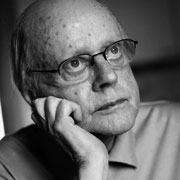
Arne Nevanlinna. Photo: Veikko Somerpuro/WSOY.
Marie Myhrborgh was born in Strasbourg on the last day of the 19th century. A hundred years later she is living her last days in a Finnish nursing home. Her mind wanders, searching for a vanished time in the landscapes of her childhood and her later life in Finland, where she was brought by a hasty marriage, formed amid the clamor of the First World War.
In his first novel Marie (WSOY, 2008) Arne Nevanlinna follows his protagonist’s associations and reminiscences, creating comic and ironic, as well as tragic parallels between the eras and the cultures that it describes.
With her marriage, Marie’s life as a Frenchwoman under the authority of the Germans changes to that of an outsider in the narrow social circles of the Finland-Swedish gentry, which her outsider’s eyes see in an ironic light. More…
Hot and cool
30 March 2008 | Authors, Reviews
The spiritual map of poetry contains many levels, and poetry happens in many decades at once.
Rakel Liehu (born 1939) published her her first poems in 1974, but she writes as freshly as any young poet of the 21st century, often about the same concomitant themes of womanhood and writing.
Liehu has the same spirit as the German dadaist Kurt Schwitters, who was a great supporter of ‘doing things differently’. There is a constant frenzy of doing things differently in her poems that reaches beyond genres. She couldn’t care less about the expectations of the times or of the mainstream. Even under threat of isolation, conventionality is anathema to her. More…
No country for young men
Issue 1/2008 | Archives online, Authors, Reviews
When men go off to war, women must do their best to take their place at home. Lauri Sihvonen examines two fictional accounts – written in 1950 and 2007 – of women in the Second World War and its aftermath
When the Continuation War broke out in June 1941, Finland was in dire need of strength to fight the Soviet Union. Field Marshal and commanderin-chief of the armed forces Carl Gustaf Emil Mannerheim wrote to the Finns in an order of the day as follows:
‘I call upon you to embark with me upon a holy war against the enemy of our nation. The fallen heroes [of the Winter War, 1939–1940] will rise again from beneath the summer hillocks to stand beside us this day, as we set out on this crusade against our enemies, firm in our purpose to ensure the future of Finland, with the glorious military might of Germany at our side and as our brothers in arms.’
Sirpa Kähkönen (born in Kuopio in 1964) has taken this wild bit of zombie fiction as the basis for her new novel; Mannerheim gets exactly what he ordered.
Lakanasiivet (‘Linen wings’, Otava), the fourth independent instalment in Kähkönen’s novel series, tells of Kuopio on 1 July 1941. This was the only day on which this largest city in northern Savo, 400 kilometres northeast of Helsinki, was bombed during the Continuation War (1941–1944). More…
The price of success
31 December 2007 | Authors, Reviews
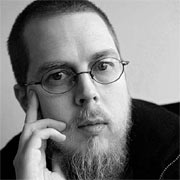
Tuomas Kyrö. Photo: Veikko Somerpuro/WSOY
A Finnish novel – or any fictitious work – that contains inaccurate historical facts can evoke bafflement in its readers, and public disapproval can follow from these ‘errors’. Finnish readers are unaccustomed to postmodernist stylistic devices. The details connected with Finnish wars, in particular, are examined under a magnifying lens.
The fourth novel by Tuomas Kyrö (born 1974), Benjamin Kivi (WSOY, 2007), stretches the boundaries of realism with its tale of a 100-year-old adventurer, written in the style of a memoir. It encompasses changing identities, periods of societal crisis, and war, which protagonist Benjamin Kivi calls simply ‘the killing’. In Finland we’re accustomed to regarding the Winter War (1939–40) and the Continuation War (1941–44) as honourable efforts to defend the country from the Soviet Union. More…
Word and non-word
Issue 4/2007 | Archives online, Authors, Reviews
For the poet Gunnar Björling (1887–1960), writing was experence, not complete, finished thought. One of his contemporaries, the writer Hagar Olsson, said: ‘Björling doesn’t write Swedish, far from it, he simply writes Björlingian.’ Trygve Söderling introduces the world of his poems, translated into English by Fredrik Hertzberg
Strange tensions and fields of energy exist between words. In the work of the Finland-Swedish modernist poet Gunnar Björling (1887–1960), with its separation of the barriers between them and its re-creation of grammar, the magnetism of words, their attraction and yearning for one another, becomes visible. More…
A womanly pursuit
Issue 4/2007 | Archives online, Authors, Reviews
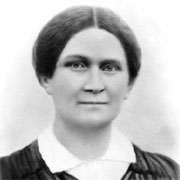
Fredrika Runeberg. Photo: Svenska litteratursällskapet i Finland
The wife of the national poet was not herself expected to write – quite the reverse, in fact. But, says Merete Mazzarella, Fredrika Runeberg (1804–1877) did
She was married to the national poet.
What is a national poet? Someone who is hugely admired in his own time, who helps to forge a national identity, who appears to bear the responsibility for the future of his people on his shoulders. Young nations like Finland – before 1809 a part of Sweden, from 1809 to 1917 an autonomous Grand Duchy under the Russian tsar – need national poets; old nations – like Sweden or Denmark – do not. A national poet is a father figure, thus almost inevitably a man.
Johan Ludvig Runeberg (1804–1877) was to become the national poet of Finland; a journalist, teacher and writer. The first poem from his collection of epic poems, Fänrik Ståls sägner (‘The tales of Ensign Stål’, 1848–60), became the national anthem. Since he was Swedish-speaking – as was the whole of the educated class at that time – we have an interesting paradox: his concept of the Finnish national character was actually created in Swedish. More…
Heroes and villains of One and Twenty
Issue 3/2007 | Archives online, Authors, Reviews
In his epic poem Kaksikymmentä ja yksi (One and Twenty, 1974) the poet Paavo Haavikko combines the imaginary ancient heroes of the national epic, the Kalevala, and the violent history of early second-millennium Byzantium, interpreting the mythical Sampo – a magical wealth-bringing device – of the Kalevala as the mint of the Byzantine empire. The American poet and critic Rachel Blau DuPlessis takes an outsider’s look at this metaphysical, capricious poetic chronicle
One and Twenty by Paavo Haavikko tells of a band of Northland adventurers who sail into the Black Sea to Byzantium via Russian lakes and portages and then return north. We do not know where the band of Twenty-One comes from precisely (are they from ‘Finland’ or from ‘Russia’)? We know only that their adventures propel them over a wide territory, from Novgorod to Byzantium. They are like nomadic mercenaries, and they witness a number of city-state and imperial power struggles in the 11th–13th centuries, well before the nation state consolidations of modernity that might call forth the idealising hero-creation of particular ‘national’ epics. More…
The wisdom of the harvester
30 September 2007 | Authors, Reviews

Eeva Tikka. Photo: Gummerus
In our fast-paced times, many people throw themselves into the fast-flowing current of stimulus. Eeva Tikka has remained on the shore, and on her own two feet. Her works include environmentally polemical tales and poems marked by nature mysticism and religious searching, but she is best known for her short prose.
Tikka (born 1939), who has won four Government Literature Prizes, worked as a biology teacher before beginning her career in writing. Her works dealing with everyday life, human relationships, and northern Karelian nature have been translated into five languages. More…
On life and death
Issue 3/2007 | Archives online, Authors, Reviews
Jouni Inkala’s selected poems are subtitled Minuutin ja sen puolikkaan laajenevassa universumissa, meaning ‘In a minute and its half’s expanding universe’ (WSOY, 2007). It blends the poems’ studious precision with a dash of poetic freedom, open wonder before ultimate questions. Inkala’s eternal themes are in fact existential: the passage of time and the question of death preoccupy the persona.
But let’s be clear about this: Inkala’s poems are not without mischief and dark humour. ‘Tail references’ is a trope of humanity and mice. ‘In two things they’re [mice] more experienced than we. / They understand they’re in constant mortal danger. / That the trap is swift and silent.’ The current condition humana, with all its peculiarities, has generated much of his poetry. Sometimes a mythical reading is implied, a comtemporary, less ‘poetical’ occasion given a mythical dimension. ‘Only several thousands years after her friend / did a woman leap down from a fourth-floor balcony.’ (‘Ikaros in Helsinki’) More…
The heart of reality
Issue 2/2007 | Archives online, Authors, Reviews
The experience of nature always inspired the poet Aaro Hellaakoski (1893–1952), but in his universe – composed of rhyme, rhythm and linguistic brilliance – existential questions remain vital.
Man is a being tied to an intersection. Like some creature floating helplessly in the water, he sees shadows of the infinite in the surface and senses the depths beneath the surface, but neither is within his grasp. The poet Aaro Hellaakoski often uses the surface of water, two-dimensional space, as a symbol of the fate of man. Expertise in the natural sciences and experience with research, both rare for a poet, left their mark on Hellaakoski’s lyrics; he received his doctorate in geography in 1929 and had a long career as a schoolteacher. More…
Fools and devils
Issue 2/2007 | Archives online, Authors, Interviews, Reviews
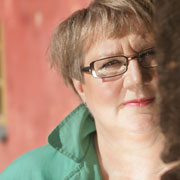
Anneli Kanto. Photo: Gummerus/Milka Alanen
Witch trials began to be history in 17th century Finland, thanks to the arrival of the country’s first university and an enlightened Governor-general. A new novel by Anneli Kanto is in those times, with a wandering theatre troupe as its focus. Anna-Leena Ekroos talks to the author
Laurentius Petrus Bircalensis, a poor boy from a backwoods village, is accepted to study at the recently founded Åbo Academy, the first university in Finland, in the town of Åbo (known as Turku in Finnish). The young studiosus, greedy for money, is more interested in occult than in theological studies, and becomes charged with witchcraft. Desperate, Laurentius flees a death sentence to wander the countryside with the Comet theatre troupe.
Journalist, theatre critic and playwright Anneli Kanto’s mischievous and adventurous first novel Piru, kreivi, noita ja näyttelijä (‘The devil, the count, the witch and the actor’) takes us to 17th-century Finland, to the days of the Swedish Count Per (Petrus) Brahe, the Governor-General of Finland. At that time the eradication of the ignorance and superstition of the peasantry was beginning in earnest. More…
-
Currently browsing
Reviews of new Finnish fiction and non-fiction
-
RSS feed
Subscribe to RSS feed for Reviews
-
Archive
- June 2015
- May 2015
- April 2015
- March 2015
- February 2015
- January 2015
- December 2014
- November 2014
- October 2014
- September 2014
- August 2014
- June 2014
- May 2014
- April 2014
- March 2014
- February 2014
- January 2014
- December 2013
- November 2013
- October 2013
- September 2013
- August 2013
- July 2013
- June 2013
- May 2013
- April 2013
- March 2013
- February 2013
- January 2013
- December 2012
- November 2012
- October 2012
- September 2012
- August 2012
- June 2012
- May 2012
- April 2012
- March 2012
- February 2012
- January 2012
- December 2011
- November 2011
- October 2011
- September 2011
- August 2011
- July 2011
- June 2011
- May 2011
- April 2011
- March 2011
- February 2011
- January 2011
- December 2010
- November 2010
- October 2010
- September 2010
- August 2010
- July 2010
- June 2010
- May 2010
- April 2010
- March 2010
- February 2010
- January 2010
- December 2009
- November 2009
- October 2009
- September 2009
- August 2009
- July 2009
- June 2009
- May 2009
- April 2009
- March 2009
- February 2009
- December 2008
- November 2008
- September 2008
- June 2008
- March 2008
- December 2007
- September 2007
- June 2007
- March 2007
- December 2006
- September 2006
- June 2006
- March 2006
- December 2005
- September 2005
- June 2005
- March 2005
- December 2004
- September 2004
- June 2004
- March 2004
- December 2003
- September 2003
- June 2003
- March 2003
- December 2002
- September 2002
- June 2002
- March 2002
- December 2001
- September 2001
- June 2001
- March 2001
- December 2000
- September 2000
- June 2000
- March 2000
- December 1999
- September 1999
- June 1999
- March 1999
- December 1998
- September 1998
- June 1998
- March 1998
- December 1997
- September 1997
- June 1997
- March 1997
- December 1996
- September 1996
- June 1996
- March 1996
- December 1995
- September 1995
- June 1995
- March 1995
- December 1994
- September 1994
- June 1994
- March 1994
- December 1993
- September 1993
- June 1993
- March 1993
- December 1992
- September 1992
- June 1992
- March 1992
- December 1991
- September 1991
- June 1991
- March 1991
- December 1990
- September 1990
- June 1990
- March 1990
- December 1989
- September 1989
- June 1989
- March 1989
- December 1988
- September 1988
- June 1988
- December 1987
- September 1987
- June 1987
- March 1987
- December 1986
- September 1986
- June 1986
- March 1986
- December 1985
- September 1985
- June 1985
- December 1984
- September 1984
- June 1984
- March 1984
- December 1983
- June 1983
- March 1983
- December 1982
- September 1982
- June 1982
- March 1982
- September 1981
- June 1981
- March 1981
- December 1980
- June 1980
- March 1980
- September 1979
- June 1979
- March 1979
- December 1978
- September 1978
- June 1978
- March 1978
- December 1977
- September 1977
- March 1977
- September 1976
- March 1976
© Writers and translators. Anyone wishing to make use of material published on this website should apply to the Editors.
